For aluminum, you would use those flux covered rods. They have nasty fumes and sticky flux. They also are expensive, and you have to have a good touch and some preheat to get them to fuse in well. I have a bunch, but have never tried them out, since they require DC. My friend tried them, and he got good results the first time, but he is already good at stick welding steel.
-
Welcome back Guest! Did you know you can mentor other members here at H-M? If not, please check out our Relaunch of Hobby Machinist Mentoring Program!
You are using an out of date browser. It may not display this or other websites correctly.
You should upgrade or use an alternative browser.
You should upgrade or use an alternative browser.
Trindle super industrial welder
- Thread starter Shootymacshootface
- Start date
- Joined
- Dec 24, 2020
- Messages
- 1,030
Yes, it's possible to stick weld aluminum, but it's not a very precise, controlled process. After going to the trouble and expense to convert the machine to DC you're still going to get pretty poor results in most cases. Aluminum presents some unique challenges when you're trying to weld it, and it's hugely different from steel or stainless.So, I have poking around on the internet, and have discovered that a dc conversion can easily be done by using a bridge rectifier. I just have to make sure that it is rated for my welders output amperage.
Has anyone done one of these conversions? And, how does it work? I know that it would improve welding in general, but what of aluminum?
- Joined
- Mar 17, 2018
- Messages
- 1,400
I actually have a need to weld some aluminum. I let a pump freeze and part of it broke, so I started my DC conversion. Fortunately it's pretty simple. Thats a 200amp rectifier mounted on a big heat sink that I had.
Here's what I got done so far.
I stopped at an Airgas welding store for some aluminum rods and didn't see any so I asked. The guy said that they haven't been able to get any for months. I told him that Tractor Supply has a bunch of Hobart aluminum rod in 3/32 and 1/8 inch. He said that if I was you I would go and get some. Thats good stuff I guess. I bought both sizes and the recommended amperage for both sizes is right in my Trindles range. I hope I welds nice. I hear that it can be a crap shoot.
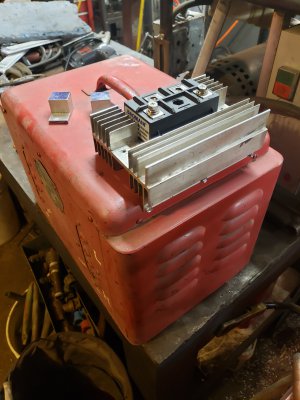
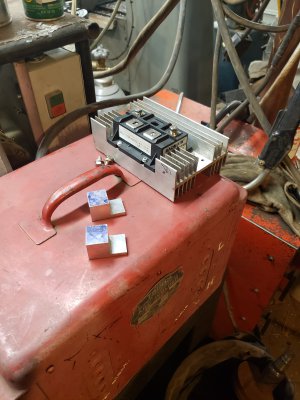
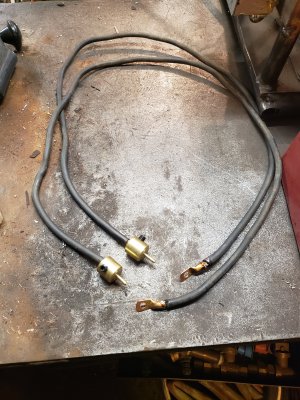
Here's what I got done so far.
I stopped at an Airgas welding store for some aluminum rods and didn't see any so I asked. The guy said that they haven't been able to get any for months. I told him that Tractor Supply has a bunch of Hobart aluminum rod in 3/32 and 1/8 inch. He said that if I was you I would go and get some. Thats good stuff I guess. I bought both sizes and the recommended amperage for both sizes is right in my Trindles range. I hope I welds nice. I hear that it can be a crap shoot.



- Joined
- Mar 17, 2018
- Messages
- 1,400
The top of the bridge rectifier was not at all strong enough for use of the push in connectors. Just a little tug on a cable, and the lugs would have broken right off. It took me a minute, but now they are rock solid.
Tomorrow we weld aluminum!
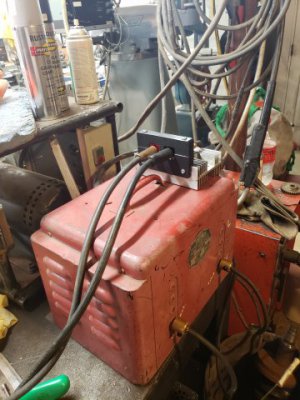
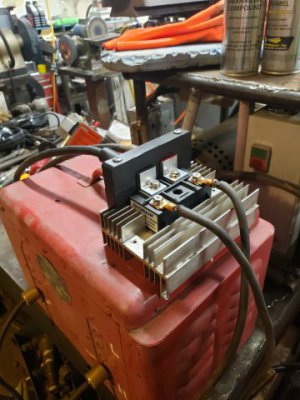
Edit.
Also, if you notice in the first few pictures how wide the lugs were. They were to fill in the entire square mounting area. When I placed them on the rectifier I noticed that they were about .1 apart. Then I said, oh "arc welder". I took .2 off the inside of each lug. It certainly would have been special when I plugged it in.
Tomorrow we weld aluminum!


Edit.
Also, if you notice in the first few pictures how wide the lugs were. They were to fill in the entire square mounting area. When I placed them on the rectifier I noticed that they were about .1 apart. Then I said, oh "arc welder". I took .2 off the inside of each lug. It certainly would have been special when I plugged it in.
Last edited:
- Joined
- Mar 17, 2018
- Messages
- 1,400
I tried to weld some aluminum scraps together tonight. It didn't go very well. It took me forever to find my stainless steel wire brush. My torch ran out of propane while I was preheating the parts. I could only get the temp up to about 200F. The rod did nothing but stick to the parts that I was trying to weld. Frustrating indeed, but towards the end I was starting to see more of an arc and the rod being consumed. So, what I think that I learned is that preheating is mandatory for this to work. I'll get a bottle of mapp gas and do a proper preheat and try again.
- Joined
- Dec 24, 2020
- Messages
- 1,030
For non-critical stuff I don't bother with the stainless wire brush...if it looks pretty clean a solid wipe with acetone is more than good enough.I tried to weld some aluminum scraps together tonight. It didn't go very well. It took me forever to find my stainless steel wire brush. My torch ran out of propane while I was preheating the parts. I could only get the temp up to about 200F. The rod did nothing but stick to the parts that I was trying to weld. Frustrating indeed, but towards the end I was starting to see more of an arc and the rod being consumed. So, what I think that I learned is that preheating is mandatory for this to work. I'll get a bottle of mapp gas and do a proper preheat and try again.
Many people trim a bit of flux off the tip of aluminum stick rods to help getting them started without sticking....even just tapping them on the bench to knock off a touch will help.
Even the guys who have a lot of experience with this method describe it as challenging and only use it when absolutely necessary.
- Joined
- Mar 17, 2018
- Messages
- 1,400
Thank you for the great tips!For non-critical stuff I don't bother with the stainless wire brush...if it looks pretty clean a solid wipe with acetone is more than good enough.
Many people trim a bit of flux off the tip of aluminum stick rods to help getting them started without sticking....even just tapping them on the bench to knock off a touch will help.
Even the guys who have a lot of experience with this method describe it as challenging and only use it when absolutely necessary.
- Joined
- Sep 2, 2013
- Messages
- 5,098
You could probably buy a DC welder for what it would cost to convert it. Miller thunderbolt buzz box or the like should be around for cheap, as most have moved on to MIG. For aluminum, just get a spool gun for your MIG. They have come way down in price for the Chinese versions, and you will be much happier with the results. I think the one you have, has earned a place as a historical conversation piece. Mike
Didn't see the later posts. Carry on. Mike
Didn't see the later posts. Carry on. Mike
Last edited:
- Joined
- Mar 17, 2018
- Messages
- 1,400
I found a 200A bridge rectifier for about $20, so I have very little into this experiment. I'm trying to ovoid having to get a second gas bottle. I wish there was one gas that would work with both aluminum and steel.You could probably buy a DC welder for what it would cost to convert it. Miller thunderbolt buzz box or the like should be around for cheap, as most have moved on to MIG. For aluminum, just get a spool gun for your MIG. They have come way down in price for the Chinese versions, and you will be much happier with the results. I think the one you have, has earned a place as a historical conversation piece. Mike
Didn't see the later posts. Carry on. Mike
- Joined
- Nov 25, 2015
- Messages
- 8,273
I always thought AL was an AC process.
I modified my HF flux core with a bridge rectifier, it turned a crappy flux core welder to a much better flux core welder. I also went 200A.
For AL I have been using the hobart brazing rod, just heat to 600-700 and add the rod, its like soldering.
I modified my HF flux core with a bridge rectifier, it turned a crappy flux core welder to a much better flux core welder. I also went 200A.
For AL I have been using the hobart brazing rod, just heat to 600-700 and add the rod, its like soldering.

